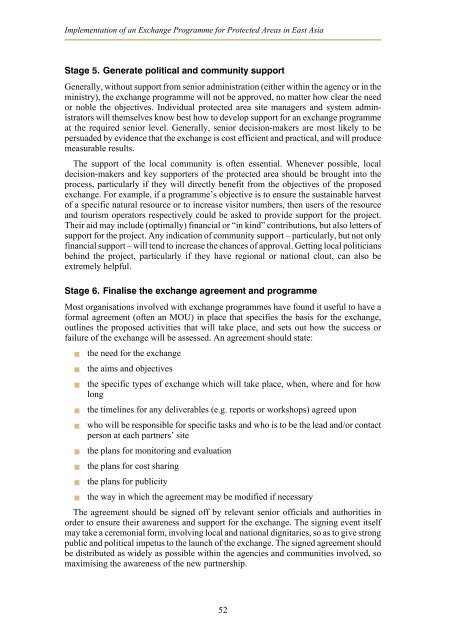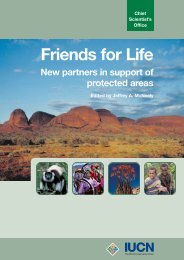Exchange programmes - IUCN
Exchange programmes - IUCN
Exchange programmes - IUCN
Create successful ePaper yourself
Turn your PDF publications into a flip-book with our unique Google optimized e-Paper software.
Implementation of an <strong>Exchange</strong> Programme for Protected Areas in East Asia<br />
Stage 5. Generate political and community support<br />
Generally, without support from senior administration (either within the agency or in the<br />
ministry), the exchange programme will not be approved, no matter how clear the need<br />
or noble the objectives. Individual protected area site managers and system administrators<br />
will themselves know best how to develop support for an exchange programme<br />
at the required senior level. Generally, senior decision-makers are most likely to be<br />
persuaded by evidence that the exchange is cost efficient and practical, and will produce<br />
measurable results.<br />
The support of the local community is often essential. Whenever possible, local<br />
decision-makers and key supporters of the protected area should be brought into the<br />
process, particularly if they will directly benefit from the objectives of the proposed<br />
exchange. For example, if a programme’s objective is to ensure the sustainable harvest<br />
of a specific natural resource or to increase visitor numbers, then users of the resource<br />
and tourism operators respectively could be asked to provide support for the project.<br />
Their aid may include (optimally) financial or “in kind” contributions, but also letters of<br />
support for the project. Any indication of community support – particularly, but not only<br />
financial support – will tend to increase the chances of approval. Getting local politicians<br />
behind the project, particularly if they have regional or national clout, can also be<br />
extremely helpful.<br />
Stage 6. Finalise the exchange agreement and programme<br />
Most organisations involved with exchange <strong>programmes</strong> have found it useful to have a<br />
formal agreement (often an MOU) in place that specifies the basis for the exchange,<br />
outlines the proposed activities that will take place, and sets out how the success or<br />
failure of the exchange will be assessed. An agreement should state:<br />
� the need for the exchange<br />
� the aims and objectives<br />
� the specific types of exchange which will take place, when, where and for how<br />
long<br />
� the timelines for any deliverables (e.g. reports or workshops) agreed upon<br />
� who will be responsible for specific tasks and who is to be the lead and/or contact<br />
person at each partners’ site<br />
� the plans for monitoring and evaluation<br />
� the plans for cost sharing<br />
� the plans for publicity<br />
� the way in which the agreement may be modified if necessary<br />
The agreement should be signed off by relevant senior officials and authorities in<br />
order to ensure their awareness and support for the exchange. The signing event itself<br />
may take a ceremonial form, involving local and national dignitaries, so as to give strong<br />
public and political impetus to the launch of the exchange. The signed agreement should<br />
be distributed as widely as possible within the agencies and communities involved, so<br />
maximising the awareness of the new partnership.<br />
52






